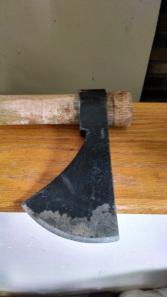This post is about killing a chicken, if that upsets you or if you don’t want to read any further then turn back now.
Spoiler alert – it ain’t pretty.
This weekend, one of our chickens got very sick – very quickly. When Addy went out to the hen house in the morning, she saw a chicken sitting in a corner.

Sure enough, when I went out to the coop, I found a chicken who was sitting down and listing to one side. When I picked her up, she twisted her neck and rotated her head upside down and below her body.
That’s not a good sign. It means that an illness or infection has gotten into the nervous system and/or brain. But still, I wanted to give her a chance and so I isolated her and kept her quiet. Later that day, Logan came up to me.
“Mom, you need to check the chicken.”
He had looked in on her and saw that she was starting to have seizures. She was shaking and her body was in spasm. Her eyes were unfocused and when she tried to get up, she kept falling down. Her nervous system was quickly being destroyed.
I teach chicken workshops and one of the topics I cover is how to humanely put down a chicken. I teach it to *everyone* who takes that class for this very reason. Even if you never intend on eating your chickens, the day may come when you have to make the decision to end a sick chicken’s life to stop its suffering.
On that day, I made that decision.
Because the hen was in such spasm, I made the decision to use an axe instead of the killing cone. I thought that putting her in the cone might have caused her unnecessary pain due to her spasms. I know, what’s a little pain when you’re going to kill her, right? But still, I didn’t want her to suffer any more than she had to.
Marc got an axe and I gently brought the bird over to a log. She didn’t fight it and in fact when I draped her neck over the log, she didn’t have the strength to even lift it up.
“This is going to be easier than I thought,” I said to myself.
Marc swung the axe. If I’m going to be honest, this was the part where I turned my head because I couldn’t look.
Here’s where I confess – I made a mistake. I made a big mistake.
I was prepared for it to be quick – a single slice and it’s over. That’s what I expected.
What I was not prepared for was the body of the chicken to try and get away after the head had been removed. I’ve heard stories of chickens running around with their heads cut off but I’ve always thought it was an exaggeration.
It’s not.
Marc and I watched for minutes (grateful that we hadn’t allowed the kids to be involved in this episode of chicken care) while our hen wildly flapped her wings like a bath toy swimming in the water.
“Oh my God,” I kept saying over and over, knowing that this memory would be going straight into that evening’s dreams as a fresh nightmare.
Eventually the body, after trying to burrow into a pile of leaves, stopped moving.
Marc and I looked at each other. “Guess I’m buying the first round of drinks tonight,” he said.
I’m here to tell you that never, never, ever again, will I use an axe on a chicken.
Never.
There is not enough bleach in the world to remove that memory from my eyes.
I teach that using the killing cone results in a relatively gentle (as gentle as death can be) end to your chicken. The bird slowly bleeds out and for the three times that we’ve done the killing cone, it looked like the bird goes to sleep.
Every time that I’ve taught about the killing cone, there is always a member of the class, usually someone who is older and who grew up around chickens, who gives me that look – the one that says, “by not using an axe you’re being a baby.”
Well go ahead and call me a baby.
Just because my grandparents did it that way, doesn’t mean that I have to. The axe although quicker, provides a level of senseless violence that I will not be a part of.
As a chicken owner, there will be times when we have to make difficult decisions. Our birds might get injured or very sick as this one was. We need to be able to make the decision to stop suffering.
I’m fine with that responsibility, it’s part of what I signed up for when I started a flock.
But I’m not fine with haunting images of a lingering, pain, and fear-filled death.
Look, no one wants to put any living creature down, it’s not a pleasant thing to do, but neither is allowing an animal under your watch to suffer. From now on, if I ever make the decision to cull another bird, it’s the killing cone only for me.
And yes, I took Marc up on that offer of a drink.
***
Wendy Thomas writes about the lessons learned while raising children and chickens in New Hampshire. Contact her at [email protected]
Also, join me on Facebook to find out more about the flock (children and chickens) and see some pretty funny chicken jokes, photos of tiny houses, and even a recipe or two.
Like what you read here? Consider subscribing to this blog so that you’ll never miss a post. And feel free to share with those who may need a little chicken love.

